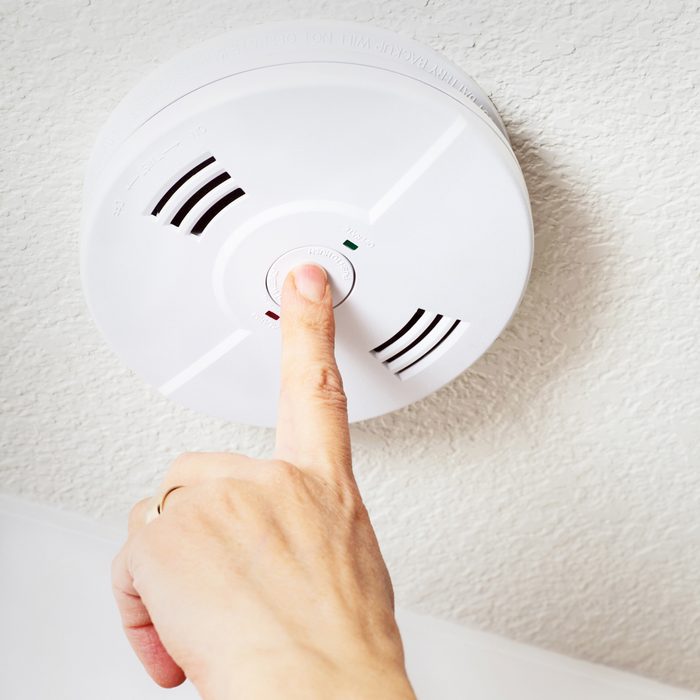How Many Smoke Detectors Do I Need?

Smoke detectors are essential for home safety. But are you unsure about how many you need, and where to put them? We've got answers.
Our editors and experts handpick every product we feature. We may earn a commission from your purchases.
Chances are, you already know smoke detectors keep your possessions and loved ones safe. But in case you need convincing: The U.S. Fire Administration and the National Fire Prevention Association confirm the risk of dying in a home fire is cut in half when working smoke alarms are present.
Even if we all agree that smoke detectors are important, it can be confusing to determine how many you needed, where they should be placed and what types are right for your unique dwelling.
Note: Almost all residential homes have “smoke alarms” rather than “smoke detectors.” We’re using the two terms interchangeably here, as that best matches common usage.
On This Page
How Many Smoke Detectors Do I Need?
The exact number and location of smoke alarms is determined by the number of floors in your home and the number of bedrooms. Your local building code may have more specific requirements. Smoke alarm manufacturer Kidde’s list of requirements in all 50 states is a great starting point.
While we can’t go into detail for each state and major city, the default guidelines fall under the International Residential Code (IRC), specifically IRC R314.3. Here are the primary points:
- Install at least one smoke alarm on each floor, including basements and habitable attics.
- Install one smoke alarm in each sleeping area, and one in any hallway a sleeping area opens into.
- Smoke alarms are not required in garages or non-habitable attics.
Note the IRC guidelines don’t address home size. If you have a particularly large bedroom, or a hallway more than 30 feet long, install a smoke detector on either side.
Remember, these guidelines give the minimum number of smoke detectors. If in doubt, install an extra. It’s a relatively small expense that might pay off massively down the road.
Where To Install Smoke Detectors
Choosing areas where smoke particles can be detected quickly, and avoid those that prevent smoke from accumulating or otherwise generate false alarms.
Smoke rises, so install the detector on the ceiling or as high up on the wall as possible. However, corners create an air buffer, making alarms less effective.
If mounting on a wall, the top of the detector must be between four and 12 inches from the ceiling. If mounting on the ceiling, it must be at least four inches from the wall. With pitched or cathedral ceilings, mount it at least four inches below the peak (measured vertically) and three feet away from the peak (measured horizontally).
Also, give some consideration to other items in the room. Installing a detector next to a ceiling fan, frequently opened window or air vent exposes it to an air current that may prevent it from functioning.
Likewise, don’t install a smoke alarm directly over your stove. Alarms should also be at least three feet from an opening to a bathroom with a shower or tub.
Alarms must be heard to be effective. When installing an alarm on a floor with no bedrooms, like an unfinished basement, place it near the stairs to allow sound to carry.
Choosing a Smoke Detector
Here are a few key factors to consider when selecting a smoke detector. There are also specialty alarms with bright strobe lights for those with hearing loss.
Sensor type
The two types are photoelectric and ionization. Photoelectric sensors are better at detecting smoldering fires, while ionization sensors are better at detecting flames. Have detectors of each type in your home, or go with a dual sensor detector that puts both in one unit.
Photoelectric models are less susceptible to false alerts, so they make good choices near kitchens and bathrooms. Per IRC R314.3.1, ionization alarms should be installed at least 20 feet from a cooking appliance, and photoelectric detectors at least six feet.
Shower steam, just like burnt toast, can trigger a false alarm. However, photoelectric alarms can be affected by altitude. If you live above 3,000 feet, use an ionization alarm.
If your home features natural gas, you’ll also need a carbon monoxide detector. A combo detector offers smoke and CO detection capability.
Power source
Smoke alarms are powered by a single battery or hardwired into your home’s electrical system. Hardwired alarms should have a battery back-up.
Modern battery-powered alarms often come with a 10-year battery, lasting the product’s lifespan. You should still test it regularly, however.
Connectivity
There are two types: connected and smart smoke alarms.
Connected smoke alarms employ wired or wireless connections. When one of them triggers, all the connected smoke detectors sound. Smart smoke alarms let you receive alerts and test the detector right from your smartphone.
Our Pick for Overall Best Smoke Detector
If you have the budget, Family Handyman recommends the Google Nest Protect Combination Smoke and CO Detector.
This dual-sensor hardwired detector features photoelectric and ionization systems and comes with Voice Alert, loudly announcing the potential danger. It’s a smart device so you’ll receive notifications if anything goes wrong, from power loss to a fire. There’s a battery-powered version available as well.
If the Nest is too much of a splurge, remember any smoke alarm is better than no smoke alarm. If you need to buy a simple model for now, do that and consider upgrading down the road.



